Sensor Sweep: Kull, Star Trek, Dying Earth, Doc Vandal
Monday , 13, July 2020 Sensor Sweep 7 CommentsPublishing (Pulp Archivist): The market is contracting, without signs of stopping, from at least the mid-2000s generational handover. Digital and its different margins have likely kept some of these magazines in business far longer than print runs can justify. It’s almost to the point where the established science fiction “fandom” does not and should not be the audience. There are 300 million people not reading science fiction short stories. The editor who can figure out how to reach even 0.0001% of that will be the king of science fiction.
Gaming (Walker’s Retreat): In other words, WOTC’s being pozzed again. Do not give money to people who hate you. Do not buy WOTC’s products new. Not for D&D. Not for Magic. Not at all. Buy used if you must, but otherwise give your money to those making their own versions of the game (legal thanks to the Open Game License making D&D open source 20 years ago). What would those be? A short list includes: Adventurer, Conqueror, King.
Science Fiction Community (Kalimac): The news has been getting out, both within and outside the SF community, that Alan Beatts, owner of Borderland Books in San Francisco, has been credibly accused of physical and sexual assault by women close to him. I’ll leave out the details; you can read them at the above links.
D&D (RPG Pundit): They say that Oriental Adventures is full of stereotypes and needs to be cancelled. And well, yes, it is full of stereotypes and not an authentic historical setting. Every other D&D setting is also full of stereotypes and not an authentic historical setting too!
Fantasy (Fantasy Literature): Kull, for those unfamiliar with the character, 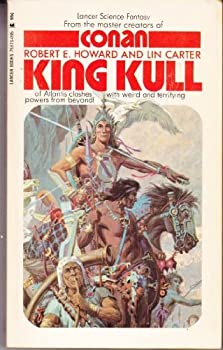 made his first appearance in the August 1929 issue of Weird Tales magazine, in the story “The Shadow Kingdom,” so no, Howard most certainly did not get his inspiration for the regal name from 1933’s King Kong. Howard would go on to write 13 more stories dealing with the character (plus one poem), but only two of those were published before his suicide death in 1936. The Lancer volume, sadly enough, is complete with the exception of two of those 14 tales.
made his first appearance in the August 1929 issue of Weird Tales magazine, in the story “The Shadow Kingdom,” so no, Howard most certainly did not get his inspiration for the regal name from 1933’s King Kong. Howard would go on to write 13 more stories dealing with the character (plus one poem), but only two of those were published before his suicide death in 1936. The Lancer volume, sadly enough, is complete with the exception of two of those 14 tales.
Star Trek (Superversive SF): cannot count the number of STAR TREK novels I have read over the years. Not as many recently as I used to, in fact, no new ones in a few years. It’s the old story, when you’re young you have all the time but limited money. When you’re older, you have the money to pursue your old hobbies like a demon but limited time. In the library, I stumbled across this Next Generation novel entitled Available Light and decided to give it a whirl. I’ve not read any new ST novels in a long time, so based on the back blurb, this one seemed like a great piece to dive back in with.
Cinema (Tulsa World): Today is the day to celebrate #Harryhausen 100. While we’re at it, let’s celebrate the lives of two people: a special effects legend and an Oklahoma cowboy who are connected by one movie at the dawn of their careers. Ray Harryhausen was the genius behind a form of stop-motion animation that brought all kinds of beasties to life in movies like “The Beast from 20,000 Fathoms,” “20 Million Miles to Earth,” “One Million Years B.C.,” “The 7th Voyage of Sinbad,” “Clash of the Titans” and a series of Sinbad flicks.
Fiction (Grubb Street): Song of the Dying Earth: Stories in Honor of Jack 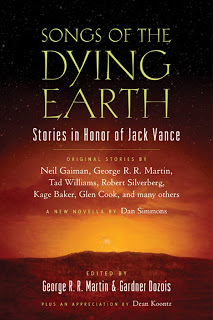 Vance, by a LOT of people you’ve heard about, edited by George RR Martin and Gardner Dozois, with Art by Paul Kidd. TOR Books, 2009. Provenance: Christmas present, probably 2009 as well. I came to Jack Vance late in life, which is a bit of a surprise given that D&D is hip-deep in Vancian notions, tropes, and outright, um, borrowings. But once I struck his Dying Earth series, in the form of a massive compendium, I was delightfully hooked by his mannered approach to far-future fantasy, and of course, when a massive tome by a cluster of big-name authors came out in his honor, I had to get it and consume it.
Vance, by a LOT of people you’ve heard about, edited by George RR Martin and Gardner Dozois, with Art by Paul Kidd. TOR Books, 2009. Provenance: Christmas present, probably 2009 as well. I came to Jack Vance late in life, which is a bit of a surprise given that D&D is hip-deep in Vancian notions, tropes, and outright, um, borrowings. But once I struck his Dying Earth series, in the form of a massive compendium, I was delightfully hooked by his mannered approach to far-future fantasy, and of course, when a massive tome by a cluster of big-name authors came out in his honor, I had to get it and consume it.
Comic Books (Wasteland & Sky): omic books need to bring back all-ages  comics as the standard. They have not been primarily aimed at children since the 1970s, and it has shown in declining sales. Comic books are an inherently juvenile format and that is their strength. Old comics and the classics could whip through plot points, action scenes, and wild settings within a single issue all while telling a complete standalone story.
comics as the standard. They have not been primarily aimed at children since the 1970s, and it has shown in declining sales. Comic books are an inherently juvenile format and that is their strength. Old comics and the classics could whip through plot points, action scenes, and wild settings within a single issue all while telling a complete standalone story.
D&D (Sacnoth’s Scriptorium): So, a few years back there was a campaign to build a Gary Gygax memorial statue in his home town of Lake Geneva. I think I even blogged about it at the time; I certainly tried to buy a copy of the memorial booklet intended to help fund the project, a collection of E.G.G.’s posts in a gaming forum, called CHEERS, GARY.
Sherlock Holmes (Black Gate): If you mention the term Gothic to most 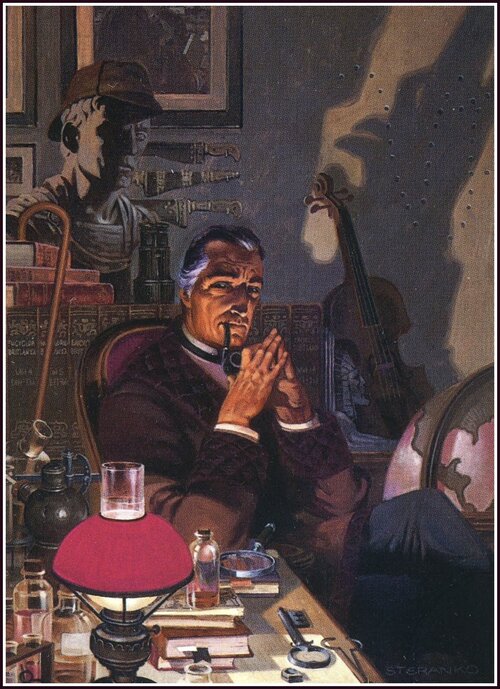 people, it’s likely to conjure visions of teenagers dressed in black, wearing black nail polish and Doc Marten boots. Someone a few years older may think of drugstore paperback racks filled with book covers featuring women in nightgowns running away from sinister mansions. But Gothic originally refers to a type of architecture, an overall aesthetic of the macabre, and a genre of fiction popular in the 18th and 19th centuries.
people, it’s likely to conjure visions of teenagers dressed in black, wearing black nail polish and Doc Marten boots. Someone a few years older may think of drugstore paperback racks filled with book covers featuring women in nightgowns running away from sinister mansions. But Gothic originally refers to a type of architecture, an overall aesthetic of the macabre, and a genre of fiction popular in the 18th and 19th centuries.
Gaming (Heavy Metal): Scorn is a long-awaited first-person shooter based  on the art of H.R. Giger and, to a lesser extent, Zdzisław Beksiński. It’s been in development for years; developer Ebb Software dropped a drool-inducing teaser trailer in 2016 and a gameplay trailer in 2017. There have been video games — lots of them — based on the Alien movies, but this one is specifically Giger, so expect to see more of the creepy, twisted sexual side of his art than you got in the Xenomorph movies.
on the art of H.R. Giger and, to a lesser extent, Zdzisław Beksiński. It’s been in development for years; developer Ebb Software dropped a drool-inducing teaser trailer in 2016 and a gameplay trailer in 2017. There have been video games — lots of them — based on the Alien movies, but this one is specifically Giger, so expect to see more of the creepy, twisted sexual side of his art than you got in the Xenomorph movies.
Pulp (The Pulp Net): While Doc Vandal is influenced by Doc Savage, he has 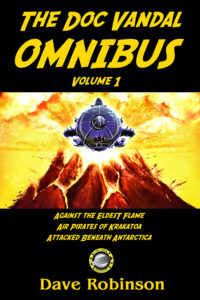 some other influences. And a big difference is that his stories are not set in our world, but in the 1930s of an alternate world that has a steampunk element where zeppelins are everywhere, aliens exists (with hidden cities on Earth, as well as the Moon), and there are other science fictional elements. Doc Vandal is an inventor and adventurer, assisted by three people: Vic, Gus and Gilly.
some other influences. And a big difference is that his stories are not set in our world, but in the 1930s of an alternate world that has a steampunk element where zeppelins are everywhere, aliens exists (with hidden cities on Earth, as well as the Moon), and there are other science fictional elements. Doc Vandal is an inventor and adventurer, assisted by three people: Vic, Gus and Gilly.
Robert E. Howard (Messages from Crom): The Cthulhu Stories of Robert E. 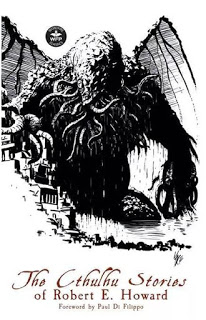 Howard. Coming in September! The Great Old Ones Return… In the early twentieth-century, in the pages of Weird Tales and other pulp magazines, H.P. Lovecraft created the Cthulhu Mythos and offered it to his friends, creating a shared mythology for much of their weird fiction. Robert E. Howard, creator of Conan the Barbarian, was one of those good friends.
Howard. Coming in September! The Great Old Ones Return… In the early twentieth-century, in the pages of Weird Tales and other pulp magazines, H.P. Lovecraft created the Cthulhu Mythos and offered it to his friends, creating a shared mythology for much of their weird fiction. Robert E. Howard, creator of Conan the Barbarian, was one of those good friends.
Popular Culture (Bronze Age Babies): Doug: Hi, my name is Doug, and… well, I’m addicted to the Planet of the Apes. There – I said it! Are you happy  now? Welcome back to the BAB, everyone! We are pleased to be in your company today, and also excited to have been asked once again to participate in this summer’s Super Blog Team-Up. “Expanded universe” is our topic, so we are running with that across three blogs. Our premise here is that the variety of products available to kids in during the era of the Bronze Age of comics allowed our imaginations to make leaps into new territory for our favorite Apes characters.
now? Welcome back to the BAB, everyone! We are pleased to be in your company today, and also excited to have been asked once again to participate in this summer’s Super Blog Team-Up. “Expanded universe” is our topic, so we are running with that across three blogs. Our premise here is that the variety of products available to kids in during the era of the Bronze Age of comics allowed our imaginations to make leaps into new territory for our favorite Apes characters.
Art (Silver Key): A big name in fantasy role-playing/Dungeons and Dragons 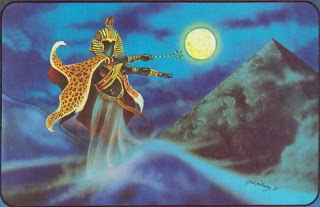 art passed away yesterday—Jim Holloway. Jim was not my favorite D&D artist of all time—I might have to go with Bill Willingham or Erol Otus—but he was one of the 5-6 most iconic and prolific of the silver or “commercial” age of TSR, circa 1981 and on.
art passed away yesterday—Jim Holloway. Jim was not my favorite D&D artist of all time—I might have to go with Bill Willingham or Erol Otus—but he was one of the 5-6 most iconic and prolific of the silver or “commercial” age of TSR, circa 1981 and on.
Tolkien (Tolkien and Fantasy): I believe that there are only two instances  where J.R.R. Tolkien was interviewed on film. The first dates from 1962, and the second from 1968. The first, by John Bowen, was conducted on 10 December 1962, in black-and-white, for the BBC television program “Bookstand”. The episode was broadcast two days later, on Wednesday, 12 December, from 10.15-10.45 pm, though the Tolkien segment took up less than nine minutes.
where J.R.R. Tolkien was interviewed on film. The first dates from 1962, and the second from 1968. The first, by John Bowen, was conducted on 10 December 1962, in black-and-white, for the BBC television program “Bookstand”. The episode was broadcast two days later, on Wednesday, 12 December, from 10.15-10.45 pm, though the Tolkien segment took up less than nine minutes.
Science Fiction (Marzaat): Scientific Romance in Britain 1890-1950. Well, 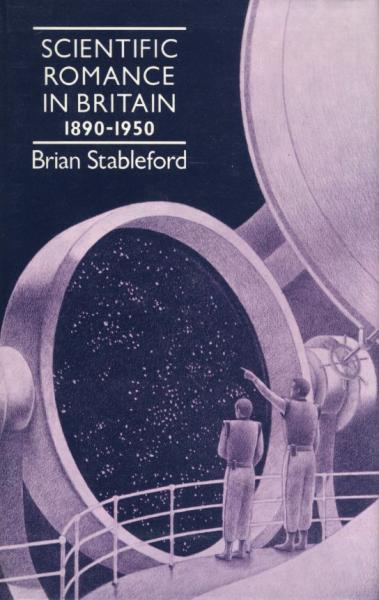 I’ve known about this book for years, but it was pricey on the second hand market, but I got it for Christmas. A lot of science fiction crit books from the 1980s I’ve purchased recently seem to be deaccessioned from university libraries. This one came from the Columbus College Library in Columbus, Georgia. It seems to have been checked out only once, in 1995. That matches Brian Stableford stating, in his essay “The Profession of Science Fiction” that he only sold “157 copies in the UK, not counting remainders”.
I’ve known about this book for years, but it was pricey on the second hand market, but I got it for Christmas. A lot of science fiction crit books from the 1980s I’ve purchased recently seem to be deaccessioned from university libraries. This one came from the Columbus College Library in Columbus, Georgia. It seems to have been checked out only once, in 1995. That matches Brian Stableford stating, in his essay “The Profession of Science Fiction” that he only sold “157 copies in the UK, not counting remainders”.
Fiction (Mostly Old Books): The First Quarry doesn’t dwell on an origin 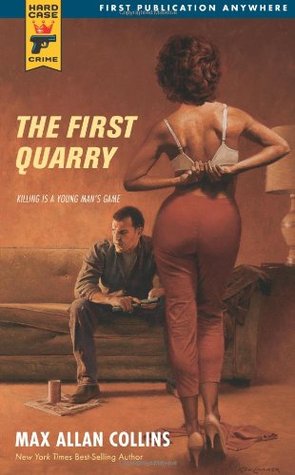 story but rather shows the young hitman being fully formed as a cold-blooded and intelligent killer as he accepts his first assignment after being recruited by The Broker – killing a college professor and destroying his manuscripts. The story takes place in Iowa in the early 1970s, the years that I came of age, and I was impressed and highly amused by all of the pop culture references from that era.
story but rather shows the young hitman being fully formed as a cold-blooded and intelligent killer as he accepts his first assignment after being recruited by The Broker – killing a college professor and destroying his manuscripts. The story takes place in Iowa in the early 1970s, the years that I came of age, and I was impressed and highly amused by all of the pop culture references from that era.
Pulp (Pulpfest): When Ned Pines was asked by The American News Company to start a chain of pulp magazines that it would distribute for him, he knew he needed an editor. The young publisher requested Frank A.  Munsey employee, Leo Margulies, to be the managing editor of his new enterprise. With the country gripped by the Great Depression, the two men came up with a daring idea for the rough paper market: a ten-cent pulp magazine. Standard Magazines, better known as “The Thrilling Group,” launched THRILLING DETECTIVE, THRILLING ADVENTURES, and THRILLING LOVE in late 1931. Each sold for a dime.
Munsey employee, Leo Margulies, to be the managing editor of his new enterprise. With the country gripped by the Great Depression, the two men came up with a daring idea for the rough paper market: a ten-cent pulp magazine. Standard Magazines, better known as “The Thrilling Group,” launched THRILLING DETECTIVE, THRILLING ADVENTURES, and THRILLING LOVE in late 1931. Each sold for a dime.
Art (DMR Books): Matthews created a considerable amount of artwork 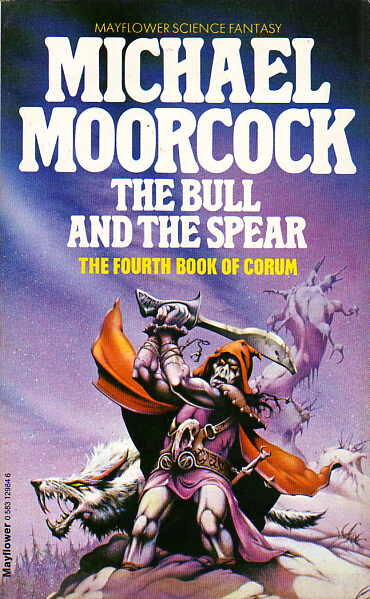 depicting Elric and various other characters from Michael Moorcock’s stories. Moorcock said that “Rodney captured the images and invention, having a larger space to work with on the posters and calendars. He was brilliant, for instance, on the quirky End of Time stories and I love his inventiveness.”
depicting Elric and various other characters from Michael Moorcock’s stories. Moorcock said that “Rodney captured the images and invention, having a larger space to work with on the posters and calendars. He was brilliant, for instance, on the quirky End of Time stories and I love his inventiveness.”
Wow what a great set of links! Many thanks.
Thanks for the mention.
“Alan Beatts, owner of Borderland Books in San Francisco, has been credibly accused of physical and sexual assault by women close to him.”
Did I read the article right? Did Beatts assault his own daughter?
Leo Margulies sounds pretty damned cool.
Hard Case Crime covers are nearly always topnotch.
Good to see the Bronze Age Babies blog back in action. Restarting with a bang! Hard to go wrong with PotA.
-
That is the suggestion, yet the author of the blog post is “unsure” how to react.
What is darkly funny about that Beatts/Borderlands link is the two leftists arguing past each other, essentially, about how much Beatts should be punished/”cancelled”, if at all.
Because we all know that if it was a Sad or Rabid Puppy, there’s no crime necessary. I can’t help laugh at the intellectual contortions. The unctuously pusillanimous spirit of Scalzi looms over the post, because apparently that crowd won’t know what to think until Scalzi gives them their cues. And he claims he lent the guy a million or two or something. So Scalzi has to figure, do I make sure he gets cancelled and ruin my chances of payback, ever? Or do I do what SJWs do and contort?
-
There is definitely a degree of tribalism going on here. Beatts, the blog author, and even the victims belong to the same in-group of SF/F fandom. I believe that’s why the victims (and the blog author) are reluctant to call for “cancelation”. Yes, if the perpetrator had been a member of the out-group (sad or rabid puppy type), there would be no such reluctance.
Thanks for the info on the new Robert E. Howard book in September. I ordered a copy.